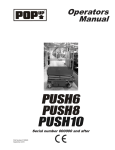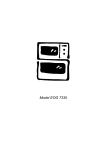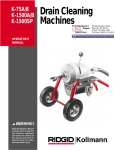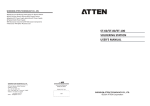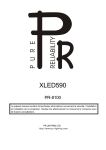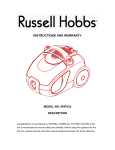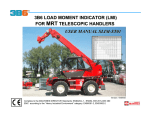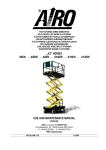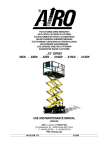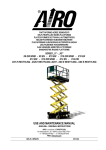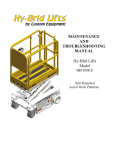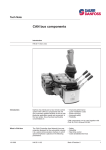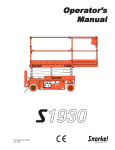Download Pop Up Pro How to Use - Pop Up Products Limited
Transcript
Elevating Work Platform Operator’s Safety and Maintenance Handbook For PUSH 6 PRO, PUSH 8 PRO and PUSH 10 PRO PUSH 6 PRO sn: 01-000025+ PUSH 8 PRO sn: 01-000368+ PUSH 10 PRO sn: 01-000050+ PN 0120843-EN July 2012 Table of Contents Table of Contents Declaration of Conformity .........................................2 Safety Rules ............................................................ 3 Introduction ...............................................................4 Component Identification .........................................4 Special Limitations ...................................................5 Platform Capacity .................................................5 Manual Force ........................................................5 Lift Level Sensor Interlock ....................................5 Lowering Alarm .....................................................5 Lowering Interrupt ................................................5 Controls and Indicators ............................................6 Lower Controls ........................................................6 Emergency Stop Button .......................................6 Control Selector Switch .........................................6 Ground Operation Button .....................................7 Platform Raise/Lower Buttons ..............................7 Battery Charger Mode Selector .............................7 Upper Controls ........................................................7 Emergency Stop Button .......................................7 Interlock Button ....................................................7 Platform Raise/Lower Buttons ..............................7 Pre-Operation Safety Inspection .............................8 System Function Inspection ....................................9 Operation ................................................................10 Preparing for Operation ..........................................10 Lower Controls ......................................................10 Upper Controls ......................................................10 PUSH PRO -0120843 Platform ................................................................ 11 Raising and Lowering ......................................... 11 Lowering Interrupt ............................................. 11 Component Tray ................................................... 11 Emergency Lowering .............................................. 11 Transporting the Machine .......................................12 Preparing for Transportation ...............................12 Transporting .......................................................12 Lifting With a Forklift ...........................................12 Lifting With a Tail Lift ..........................................12 Maintenance ..........................................................13 Hydraulic Fluid ....................................................13 Check Hydraulic Fluid .........................................13 Battery Maintenance ..........................................13 Battery Charging ................................................13 Inspection and Maintenance Schedule ..................14 Daily Preventative Maintenance Checklist .............15 Preventative Maintenance Report .......................15 General Specifications – PUSH 6 PRO ..................16 General Specifications – PUSH 8 PRO ..................17 General Specifications – PUSH 10 PRO ................18 1 EC DECLARATION OF CONFORMITY FOR MACHINERY MACHINERY: Powered Aerial Platform known as: Type: Pop Up PUSH PRO Serial Number: PUSH8-04-xxxxxx The machine specified above conforms to the following provisions: Machinery directive 2006/42/EC (using document EC Community Legislation on Machinery and taking guidance from EN280:2001 + Amendment A2:2009) Council Directive 2004/108/EC on Electromagnetic Compatibility Council Directive 2006/95/EC on Low Voltage Equipment Safety Type approval in accordance with 2006/42/EC performed by: Powered Access Certification LTD P. O. Box 98, Windermere Cumbria, LA23 1WF, UK Notified Body Identification Number: 0545 E. C. Type Examination Certificate No: Authorized Representative in European Union: The Tanfield Group, PLC Vigo Centre, Birtley Road Washington, Tyne & Wear NE38 9DA, UK Note: Modification of the specified unit renders this declaration invalid. 2 PUSH PRO -0120843 SAFETY RULES ! Warning All personnel shall carefully read, understand and follow all safety rules and operating instructions before operating or performing maintenance on any Pop Up aerial work platform. Elektrocution Hazard Tip Over Hazard THIS MACHINE IS NOT INSULATED! NEVER elevate the platform or drive the machine while elevated unless the machine is on a firm, level surface. Collision Hazard Fall Hazard NEVER position the platform NEVER climb, stand, or without first checking for sit on platform guardrails overhead obstructions or other or midrail. hazards. USE OF THE AERIAL WORK PLATFORM: This aerial work platform is intended to lift persons and his tools as well as the material used for the job. It is designed for repair and assembly jobs and assignments at overhead workplaces (ceilings, buildings etc.). Uses or alterations to the aerial work platform must be approved by Pop Up. THIS AERIAL WORK PLATFORM IS NOT INSULATED! For this reason it is imperative to keep a safe distance from live parts of electrical equipment! Exceeding the specified permissible maximum load is prohibited! See “Platform Capacity” on page 5 for details. The use and operation of the aerial work platform as a lifting tool or a crane is prohibited! NEVER exceed the manual force allowed for this machine. See “Manual Force” on page 5 for details. DISTRIBUTE all platform loads evenly on the platform. NEVER operate the machine without first surveying the work area for surface hazards such as holes, drop-offs, bumps, curbs, or debris; and avoiding them. OPERATE machine only on surfaces capable of supporting wheel loads. NEVER operate the machine outdoors or indoors when wind speeds exceed 0 m/s (0 mph). Do not operate the aerial platform in windy or gusty conditions. Do not add anything to or take anything into the aerial platform that will increase the wind loading such as billboards, banners, flags, etc. IN CASE OF EMERGENCY push EMERGENCY STOP switch to deactivate all powered functions. IF ALARM SOUNDS while platform is elevated, STOP, carefully lower platform. Move machine to a firm, level surface. Climbing up the railing of the platform, standing on or stepping from the platform onto buildings, steel or prefab concrete structures, etc., is prohibited! Dismantling the entry gate or other railing components is prohibited! Always make certain that the entry gate is closed! It is prohibited to keep the entry gate in an open position when the platform is raised! To extend the height or the range by placing of ladders, scaffolds or similar devices on the platform is prohibited! NEVER perform service on machine while platform is elevated without blocking elevating assembly. INSPECT the machine thoroughly for cracked welds, loose or missing hardware, hydraulic leaks, loose wire connections, and damaged cables or hoses before using. VERIFY that all labels are in place and legible before using. NEVER use a machine that is damaged, not functioning properly, or has damaged or missing labels. To bypass any safety equipment is prohibited and presents a danger for the persons on the aerial work platform and in its working range. NEVER charge batteries near sparks or open flame. Charging batteries emit explosive hydrogen gas. Modifications to the aerial work platform are prohibited or permissible only at the approval by Pop Up. AFTER USE, secure the work platform from unauthorized use by turning the keyswitch off and removing key. The driving of MEWP’s on the public highway is subject to national traffic regulations. Certain inherent risks remain in the operation of this machine despite utilizing proper design practices and safeguarding. Care must be taken to ensure that the machines meets the requirements of stability during use, transportation, assembly, dismantling when out of service, testing, or foreseeable breakdowns. In the event of an accident or breakdown see “Emergency Lowering” on page 11, do not operate the aerial platform if it is damaged or not functioning properly. Qualified maintenance personnel must correct the problem before putting the aerial platform back into service. PUSH PRO -0120843 3 Introduction Introduction When contacting Pop Up for service or parts information, be sure to include the MODEL and SERIAL NUMBERS from the equipment nameplate. Should the nameplate be missing, the SERIAL NUMBER is also stamped on the front of the chassis. This manual covers the PUSH 6 PRO, PUSH 8 PRO, and PUSH 10 PRO Aerial Work Platforms. This manual must be stored on the machine at all times. Read, understand and follow all safety rules and operating instructions before attempting to operate the machine. Component Identification Platform Upper Controls Entry Gate Operators Manual Guardrails Toeboards Component Tray Scissors Structure Hydraulic Reservoir/Pump • Batteries Safety Prop One on Each Side Forklift Pocket Chassis Forklift Pocket Lower Controls Brake Lever Battery Charge Indicator Right Side Emergency Lowering Lever Nameplate Rear 4 PUSH PRO -0120843 Table of Contents Special Limitations Elevating the platform is limited to firm, level surfaces only. ! Danger The elevating function shall ONLY be used when the work platform is level and on a firm surface. The work platform is NOT intended to be pushed over uneven, rough, or soft terrain. Platform Capacity One person and tools may occupy the platform when the machine is indoors only. The maximum platform capacity for the aerial platform is stated in the “Specifications” on pages 16 to 18. ! Danger DO NOT exceed the maximum platform capacity or the platform occupancy limits for this machine. Manual Force Manual force is the force applied by the occupants to objects such as walls or other structures outside the work platform. In zero wind conditions the maximum allowable manual force is limited to 200 N. ! Danger DO NOT exceed the maximum amount of manual force for this machine. Lift Level Sensor Interlock The aerial platform lift function is interlocked through a level sensor system. If the chassis is tilted more than 2 degrees side-to-side or front-to-rear, an alarm will sound when the power is turned on and the lift function will not operate. When the alarm sounds, only the platform lower function will operate. Position the machine on a level surface when the lift level sensor alarm sounds. When the machine is properly positioned on a level surface, the alarm will not sound and all functions will be operational. The lift level sensor system is for added protection and does not justify operating on anything other than firm, flat, level surfaces. Lowering Alarm When a platform control button is pressed to lower the platform, the alarm emits a loud beeping sound to warn personnel in the work area to stand clear. ! Danger Pinch points exist on the scissors structure. Death or serious injury will result if the scissors structure lowers onto personnel within the scissors arms or under the raised platform. Stand clear while raising and lowering the platform. Be careful when lowering the platform. Keep hands and fingers away from the scissors structures components. Lowering Interrupt When the platform is lowered to about 1.5 m (5′) lowering stops. The platform will not lower for five seconds regardless of the control position to allow personnel to clear the area of the scissors before the platform completely lowers. Release the control to reset the lowering function, then continue to lower the platform. WIND SPEED BEAUFORT RATING m/s km/h ft/s 3 3,4~5,4 12,25~19,4 11,5~17,75 4 5,4~8,0 19,4~28,8 17,75~26,25 12,0~18 5 8,0~10,8 28,8~38,9 26,25~35,5 with leaves start swaying. Wave crests are apparent in 18~24,25 Shrubs ponds or swamps. 6 10,8~13,9 38,9~50,0 35,5~45,5 24,5~31 7 13,9~17,2 50,0~61,9 45,5~56,5 31.~38,5 Whole trees sway. It is difficult to walk against the wind. GROUND CONDITIONS mph 7,5~12,0 Papers and thin branches move, flags wave. Dust is raised, paper whirls up, and small branches sway. Tree branches move. Power lines whistle. It is difficult to open an umbrella. Figure 1 – Beaufort Scale PUSH PRO -0120843 5 Controls and Indicators Controls and Indicators The operator shall know the location of each control and indicator and have a thorough knowledge of the function and operation of each before attempting to operate the machine. 1 3 2 4 5 ! Danger Pinch points may exist between moving components. Death or serious injury will result from becoming trapped between components, buildings, structures, or other obstacles. Make sure all personnel stand clear while operating the aerial platform. • Controls to position the platform are located on the lower control panel on the chassis and on the upper control panel in the platform. 6 Lower Controls The lower controls (refer to Figure 2) are located on the right side of the chassis. 7 10 8 9 The following are located on the lower control panel: 11 Figure 2 – Lower Controls and Indicators 1. Tilt/lowering alarm 2. Battery charge indicator 3. 110V battery charger plug 4. Battery charger mode selector 5. 230V/240V battery charger plug 6. Tray latch 7. Ground operation button 8. Platform raise button 9. Emergency stop button 10. Platform lower button 11. Control selector switch • Emergency stop button • Control selector switch • Ground operation button • Platform raise/lower buttons • Battery charger selector/plugs/indicator ! Warning The aerial platform is free to move when the brakes are released. Death or serious injury can result. Engage the brakes before operating the aerial platform. Emergency Stop Button The emergency stop is a two-position red push button. • Push the button inward to disconnect power to all control circuits. 15 16 13 • Pull the button outward to restore power. Control Selector Switch Insert the key into the control selector switch. • Turn the switch to the lower controls position to operate aerial platform functions from the lower controls. The upper controls will not operate while the control selector is in the lower position. 14 12 • Turn the switch to the upper controls position to operate the aerial platform functions from the upper controls. • In the center position, aerial platform functions will not operate from the lower or upper controls. Figure 3 – Upper Controls and Indicators 12. Interlock button 13. Battery condition indicator 14. Platform lower button 15. Platform raise button 16. Emergency stop button 6 PUSH PRO -0120843 Controls and Indicators Ground Operation Button The ground operation button prevents platform movement if the platform raise or lower button is accidentally pressed. This switch is spring returned to the off position. Press and hold the ground operation switch inward continually to operate the machine from the lower controls. Platform Raise/Lower Buttons The platform raise/lower buttons are used to raise or lower the platform. The buttons are spring returned to the off position. Emergency Stop Button The emergency stop is a two-position, red push button on the right side of the upper control panel. • Push the button inward to disconnect power from all control circuits at the upper controls. • Twist the button clockwise to restore power. Push the button in when the upper controls are not in use to help protect against unintentional platform operation. • Press and hold the platform raise button to raise the platform. Interlock Button The interlock button prevents platform movement if the platform raise or lower button is accidentally pressed. This switch is spring returned to the off position. • Press and hold the platform lower button to lower the platform. Press and hold the interlock button inward continually to operate the machine from the upper controls. • An alarm will sound as the platform lowers. Battery Charger Mode Selector The battery charger may be operated on either 110V or 230V/240V electrical circuits. Platform Raise/Lower Buttons The platform raise/lower buttons are used to raise or lower the platform. The buttons are spring returned to the off position. • Move the toggle switch to the left for operation on 110V circuits. • Press and hold the platform raise button to raise the platform. • Move the toggle switch to the right for operation on 230V/240V circuits. • Press and hold the platform lower button to lower the platform. • In the middle position, the battery charger is off and will not charge. • An alarm will sound as the platform lowers. Upper Controls The upper controls (refer to Figure 3) are located on the control panel at the front of the platform. The following controls are located on the upper control panel: • Interlock button • Battery condition indicator • Platform raise/lower buttons • Emergency stop button ! Warning The aerial platform is free to move when the brakes are released. Death or serious injury can result. Engage the brakes before operating the aerial platform. PUSH PRO -0120843 7 Pre-Operation Safety Inspection Pre-Operation Safety Inspection Note Carefully read, understand and follow all safety rules, operating instructions, labels and National Safety Instructions/Requirements. 1. Open the tray and inspect for damage, fluid leaks or missing parts daily. 2. Check daily the level of the hydraulic fluid with the platform fully lowered. The fluid level must be within 6 mm (¼″) of the top of the fill hole. Add recommended hydraulic fluid if necessary. See “Specifications” on pages 16 to 18. 3. Check weekly that the fluid level in the batteries is correct. See “Battery Maintenance” on page 15. 4. Verify that the batteries are charged daily. 5. Check daily that the AC extension cord has been disconnected from the outlet on the side of the chassis. 6. Inspect the brakes daily on the rear castor wheels for proper operation. Step down on the brake levers and verify that the machine will not move. 7. Check daily that all guardrails are in place and all fasteners are properly tightened. 8. Inspect the machine thoroughly each day for cracked welds and structural damage, loose or missing hardware, hydraulic leaks, damaged control cable and loose wire connections. 8 PUSH PRO -0120843 System Function Inspection System Function Inspection 6. Test the emergency lowering system for proper operation. ! Warning 7. Push the Lower Control Emergency Stop Button to check for proper operation. All machine functions should be disabled. Pull the Lower Control Emergency Stop Button outward to resume. Refer to “Controls and Indicators” on page 6 for the locations of various controls and indicators. STAND CLEAR of the work platform while performing the following checks. Before operating the machine, survey the work area for surface hazards such as holes, drop-offs, bumps and debris. Check in ALL directions, including above the work platform, for obstructions and electrical conductors. 1. Move the machine, if necessary, to unobstructed area to allow for full elevation. an 2. Pull the Lower Control Emergency Stop Switch to the ON position. 3. Turn the Upper Control Emergency Stop Switch clockwise to the ON position. 4. Visually inspect the scissors structure, lift cylinder, and hoses for cracked welds and structural damage, loose hardware, hydraulic leaks, loose wire connections, and erratic operation. Check for missing or loose parts. 8. Enter the platform and close the gate. 9. Check that the route is clear of obstacles (persons, obstructions, debris), is level, and is capable of supporting the wheel loads. 10.Test each machine function from the upper control station by engaging the interlock and operating the function controls (refer to Figure 3). 11. Push the Upper Control Emergency Stop Button to check for proper operation. All machine functions should be disabled. Turn the Upper Control Emergency Stop Button clockwise to resume. 12.Check to ensure that the Auto Brake system works correctly by raising the machine slightly from the lower controls. Check that the brake is engaged against the rear castor wheels. Check to make sure the machine will not move when elevated. 5. Press and hold the ground operation button inward. Test each machine function from the lower control station (refer to Figure 2). PUSH PRO -0120843 9 Operation Operation The aerial platform may be operated from either the lower or upper controls. 4. Step down on each of the brake levers to lock the rear wheels in position. Verify that the brakes are engaged before entering the platform. ! Danger The aerial platform is not electrically insulated. Death or serious injury will result from contact with, or inadequate clearance from, an energized conductor. Do not go closer than the minimum safe approach distance as defined by national safety regulations. Pinch points may exist between moving components. Death or serious injury will result from becoming trapped between components, buildings, structures, or other obstacles. Make sure there is sufficient clearance around the machine before moving the chassis or platform. Allow sufficient room and time to stop movement to avoid contact with structures or other hazards. The aerial platform can tip over if it becomes unstable. Death or serious injury will result from a tip-over accident. Operate the aerial platform on a firm, flat, level surface. Engage both of the rear brakes befor entering the platform. Do not position the aerial platform for elevated use near any dropoff, hole, slope, soft or uneven ground, or other tip-over hazard. Do not raise the platform in wind speeds above 0 m/s. The platform rated work load is the total weight of the personnel and equipment that may be lifted in the platform. The work loads are stated on the platform rating placard at the entrance to the platform. ! Danger Lower Controls The platform raise and lower functions may be operated from the lower controls. The lower controls may be used for initial set up of the aerial platform, and for testing and inspection. Use the following procedure to raise or lower the platform using the lower controls. 1. Pull the emergency stop button outward (refer to Figure 2). 2. Insert the key into the control selector switch and turn the switch to the lower controls position. 3. Press and hold the ground operation button inward. • To raise the platform, platform raise button. press and hold the • To lower the platform, press and hold the platform lower button. 4. Release the button to stop movement. Upper Controls Before operating the upper controls, properly set up the aerial platform as described under Preparing for Operation. Use the following procedure to operate the aerial platform from the upper controls: The aerial platform can tip over if it becomes unstable. Death or serious injury will result from a tip-over accident. Do not exceed the capacity values indicated on the platform rating placard. Capacity values indicate the rated lifting capacity and do not indicate aerial platform stability. The operator bears ultimate responsibility for ensuring that the aerial platform is properly set up for the particular conditions encountered. Preparing for Operation Use the following procedure to prepare the aerial platform for operation: 1. Perform a pre-operation safety and system function inspection. 2. Close and latch the component tray. 3. Position the machine in the work place and make certain the area is flat and horizontal. 10 PUSH PRO -0120843 Operation 1. From the lower controls, pull the emergency stop button outward (refer to Figure 2). 2. Insert the key into the control selector switch and turn the switch to the upper controls position. Note The upper controls will not operate while the control selector is in the lower position. 3. Enter the platform and secure the gate. 4. From the upper controls, turn the emergency stop button clockwise to the on position (refer to Figure 3). 5. The platform may be raised and lowered from the upper controls. Platform Use care when entering and exiting the platform to avoid slipping and/or falling. Securely close the safety gate when the platform is occupied. Raising and Lowering Press and hold the interlock button on the left side of the upper control box. • To raise the platform, press and hold the platform raise button until the desired height is reached. • To lower the platform, press and hold the platform lower button until the desired height is reached. Lowering Interrupt When the platform is lowered to about 1.5 m (5′) lowering stops. The platform will not lower for five seconds regardless of the joystick position. Release the platform lower button to reset the lowering function, then continue to lower the platform. PUSH PRO -0120843 Component Tray Batteries and hydraulic components are enclosed in the component tray on the left side of the chassis. ! Danger The aerial platform can tip over if it becomes unstable. Death or serious injury can result from a tip-over accident. Do not open the tray when the platform is elevated. To open the tray, lift up on the tray latch and pull the tray open. Emergency Lowering Use the following procedure to operate the emergency lowering system. ! Warning The potential for an accident increases when safety devices do not function properly. Death or serious injury can result from such accidents. Immediately push the emergency stop button inward to disable the control system before using the emergency lowering system in the event of an emergency. 1. Immediately push the emergency stop button inward to disable the control system in the event of an emergency. 2. Make sure there is nothing in the way to obstruct the platform when it lowers. • Push downward on the lever to lower the platform. 3. Make certain the lever/handle is fully released and the emergency lowering valve is fully closed before operating the aerial platform. 11 Transporting the Machine Transporting the Machine Preparing for Transportation Use the following procedure to prepare the aerial platform for transportation. Lifting With a Tail Lift Use the following procedure to lift the aerial platform with a forklift. 1. Properly stow the aerial platform. 1. Remove any unnecessary tools, materials, or other loose objects from the platform. 2. Remove all personnel, tools, materials, or other loose objects from the platform. 2. Close and latch the component tray. 3. Position the aerial platform on the tail lift. Transporting The equipment used to load, unload, and transport the aerial platform must have adequate capacity. The empty vehicle weight is listed in “Specifications” on pages 16 to 18 and is stamped on the serial number placard. 4. Engage the brakes on both of the rear wheels. 5. Carefully raise the lift and position the aerial platform in the transport vehicle. 6. Secure the machine to the transport vehicle using straps through the fork lift pockets. The user assumes all responsibility for: • Choosing the proper method of transportation. • Choosing the proper selection and use of transportation and tie-down devices. • Making sure the equipment used is capable of supporting the weight of the aerial platform. • Making sure all manufacturer’s instructions and warnings, regulations and safety rules of their employer, the DOT, and/or any other state or federal law are followed. Lifting With a Forklift Use the following procedure to lift the aerial platform with a forklift. 1. Properly stow the aerial platform. 2. Engage the brakes on both of the rear wheels. 3. Remove all personnel, tools, materials, or other loose objects from the platform. 4. Insert the forklift forks into the pockets on either side of the machine. ! Caution Lifting the aerial platform with the forklift forks positioned improperly can produce enough force to damage machine components. When lifting the machine with a forklift, only use the designated lift points. 5. Do not raise the aerial platform higher than necessary to transport it. Drive the forklift slowly and carefully when transporting the aerial platform. 12 PUSH PRO -0120843 Maintenance Maintenance Check Hydraulic Fluid ! Warning Always block the elevating assembly whenever it is necessary to perform maintenance while the platform is elevated. Use the following procedure to properly position the safety props: 1. Remove all tools and material from the platform. 2. Using the lower controls, raise the platform until the open distance on the chassis is wide enough to position the safety props. Refer to Figure 5. 1. Make sure that the platform is fully lowered. 2. Visually check to make sure the fluid is within 6 mm (¼″) of the top of the fill hole. 3. If necessary, remove the filler cap and add fluid of the proper type. Replace the cap making sure it is tightly in place. Refer to “Specifications” pages 16 to18. Battery Maintenance ! Warning Hazard of explosive gas mixture. Keep sparks, flame, and smoking material away from the battery. Always wear safety glasses when working near the battery. Battery fluid is highly corrosive. Thoroughly rinse away any spilled fluid with clean water. Safety Prop Always replace the battery with a manufacturer approved replacement. • Check the battery fluid level weekly, especially if the machine is being used in a warm, dry climate. Figure 5 – Safety Props 3. Rotate the safety props downward from the storage position to the support position. • If electrolyte level is lower than 6 mm (¼″) above the plates add distilled water only. DO NOT use tap water with high mineral content, as it will shorten battery life. • Keep the terminals and top of the battery clean. 4. Remove hands and arms from the scissors area. • Refer to the Service Manual to extend battery life and for complete service instructions. 5. Lower the platform until the scissors are supported by the safety props. ! Warning Hydraulic Fluid The hydraulic fluid reservoir is located in the component tray. Refer to Figure 6. Reservoir Fill Cap Always use manufacturer approved replacement parts. Battery Charging Charge the battery at the end of each work shift or sooner if the battery has been discharged. Note: The PUSH series has a built in feature whereby power is cut to the machine when the battery level reaches 94.5% or 11.34v of the original 12v supply, this is to prevent excessive wear or damge to the battery. The machine should immediately be placed on charge if this occurs. ! Warning Charge the battery in a well ventilated area. Do not charge the battery when the machine is near a source of sparks or flames. Figure 6 – Component Tray Note Never add fluid if the platform is elevated. PUSH PRO -0120843 Permanent damage to the battery will result if the battery is not immediately recharged after discharging. Never disconnect the cables from the battery when the charger is operating. 13 Inspection and Maintenance Schedule Keep the charger dry. 1. At the lower controls, turn the control selector switch to the off position. 2. Open the component tray to access the battery. Remove the caps from the battery. 3. Visually check the battery fluid level making sure the level is within 6 mm (¼″) of the bottom of the filler neck inside each hole. If needed, add distilled water. 4. Tightly replace the caps on each battery and replace and latch the battery tray covers. 5. Place the battery charger mode selector, on the lower control panel, in the appropriate position for power source being used. • Move the toggle switch to the left for operation on 110V circuits. • Move the toggle switch to the right for operation on 230V240V circuits. 6. Plug the battery charger into a properly grounded outlet (100-240 volt AC, 50/60 Hz) using a 3 conductor, 1.5 mm (12 gauge) or larger extension cord. The extension cord must be as short as possible and in good electrical condition. 7. Visually inspect the battery charge indicator for proper charging rate. The LED’s are visible on the left side of the lower controls. Refer to Figure 7 for the function of each LED. The battery should be fully charged when the 95% LED is on. Figure 7 – Battery Charge Indicator 8. Leave the battery charger plugged in until it shuts itself off. Note If the charging cycle exceeds 16 hours without the battery being fully recharged, unplug the charger and have the battery checked. 9. After the battery charger turns itself off, it is not necessary to immediately unplug the extension cord from the battery charger. The charger will monitor the charge state of the battery and recharge them if the voltage drops off. 10.Slide the component tray open to access the battery. Remove the caps from the battery. 11. Visually check the battery fluid level making sure the level is within 6 mm (¼″) of the bottom of the filler neck inside each hole. If needed, add distilled water. 12.Tightly replace the caps on the battery and close and latch the component tray. Inspection and Maintenance Schedule ! Caution Frequency and extent of periodic examinations may depend on national regulations. The Complete Inspection consists of periodic visual and operational checks, along with periodic minor adjustments that assure proper performance. Daily inspection will prevent abnormal wear and prolong the life of all systems. The inspection and maintenance schedule should be performed at the specified intervals and after prolonged periods of storage before returning the machine to service. Inspection and maintenance shall be performed by personnel who are trained and familiar with mechanical and electrical procedures. ! Warning Steady Red When Charger Is Plugged In 25% Charge 95% Charge Flashes During Charging 14 Before performing preventative maintenance, familiarize yourself with the operation of the machine. Always block the scissors structure whenever it is necessary to perform maintenance while the platform is elevated. The daily preventative maintenance checklist has been designed for machine service and maintenance. Please photocopy the Daily Preventative Maintenance Checklist and use the checklist when inspecting the machine. PUSH PRO -0120843 Daily Preventative Maintenance Checklist Daily Preventative Maintenance Checklist Preventative Maintenance Report Date:_____________________________________ Serial No:__________________________________ Owner:____________________________________ Serviced By: _______________________________ Model No: _________________________________ Item Inspect For Operator’s Manual Y N R In manual holder, all pages readable and intact Electrical System Battery terminals Clean, connectors tight Battery charge indicator Proper operation Battery charger Proper operation Cables and wiring harness No wear or physical damage Hydraulic System Fluid level Between full and add marks with platform stowed Hoses, tubes and fittings No leaks, all fittings tight Castors Good condition, no damage/smooth movement Manual Brakes Proper operation, no damage or deformation Lower Control Station Operating controls Proper operation Emergency stop Shuts off lower controls/proper operation Lowering alarm and interrupt Sounds when platform lowers/proper operation Emergency Lowering Proper operation Safety Prop No damage or deformation Structures Weldments – Scissors, chassis, steps, platform, etc. Welds intact, no damage or deformation Platform slide rollers In place, no damage or deformation Fasteners In place, tight, and no damage Upper Control Station Guardrail system Welds intact, no damage or deformation All fasteners in place, no loose or missing parts Platform floor No damage or deformation Clean to prevent slip and fall hazards Entry gate Proper operation, no damage or deformation Operating controls Proper operation/raise and lower Lowering delay Proper operation, limit switch delays lowering Emergency stop Shuts off upper controls Operation and Safety Decals In place and readable Maintenance Table Key: Y = Yes/Acceptable, N = No/Not Acceptable, R = Repaired/Acceptable PUSH PRO -0120843 15 Specifications General Specifications – PUSH 6 PRO Aerial Platform Working height Maximum platform height Wheelbase Ground clearance Maximum wheel load Maximum ground pressure Floor loading Weight, EVW Approximate Stowed width Stowed length Stowed height 3.83 m 1.83 m 1m 1.9 cm 267 kg 10.4 kg/cm² 782 kg/m² 295 kg 76.2 cm 1.23 m 1.59 m Platform Dimensions 51.3 cm x 109 cm Guardrail height 110.4 cm Toeboard height 15.3 cm Rated work load 240 kg Maximum number of occupants 1 indoors Function Speed Platform raise Platform lower 6 to 10 seconds 6 to 10 seconds Lift Level Sensor Interlock Side-to-side Front-to-rear Tires 16 2 degrees 2 degrees Electrical System Voltage 12 V DC negative chassis ground Source One - 12 V 105 amp hour battery Fluid recommended distilled water Charger 15 amp Hydraulic System Maximum pressure 19,305 kPa Pressure Relief Valve Setting 2,000 psi Reservoir capacity 3.78 l System capacity 3.78 l Maximum operating temperature 71°C (160°F) Hydraulic fluid recommended Above -13°C (10°F) ISO VG32 (Mobil DTE-13M) Below -13°C (10°F) ISO VG15 (Mobil DTE-11M) Ambient Air Temperature Operating Range Celsius -18°C to 43°C Fahrenheit 0°F to 110°F Maximum Wind Speed Gust or steady Vibration Sound Pressure Level At work station 0 m/s less than 2.5 m/sec² below 70 dB(A) Nonmarking solid rubber PUSH PRO -0120843 Specifications General Specifications – PUSH 8 PRO Aerial Platform Working height Maximum platform height Wheelbase Ground clearance Maximum wheel load Maximum ground pressure Floor loading Weight, EVW Approximate Stowed width Stowed length Stowed height 4.43 m 2.43 m 1m 1.9 cm 287 kg 11.1 kg/cm² 835 kg/m² 331 kg 76.2 cm 1.23 m 1.67 m Platform Dimensions 51.3 cm x 109 cm Guardrail height 110.4 cm Toeboard height 15.3 cm Rated work load 240 kg Maximum number of occupants 1 indoors Function Speed Platform raise Platform lower 6 to 12 seconds 8 to12 seconds Lift Level Sensor Interlock Side-to-side Front-to-rear Tires PUSH PRO -0120843 2 degrees 2 degrees Electrical System Voltage 12 V DC negative chassis ground Source One - 12 V 105 amp hour battery Fluid recommended distilled water Charger 15 amp Hydraulic System Maximum pressure 19 305 kPa Pressure Relief Valve Setting 2,000 psi Reservoir capacity 3.78 l System capacity 3.78 l Maximum operating temperature 71°C (160°F) Hydraulic fluid recommended Above -13°C (10°F) ISO VG32 (Mobil DTE-13M) Below -13°C (10°F) ISO VG15 (Mobil DTE-11M) Ambient Air Temperature Operating Range Celsius -18°C to 43°C Fahrenheit 0°F to 110°F Maximum Wind Speed Gust or steady Vibration Sound Pressure Level At work station 0 m/s less than 2.5 m/sec² below 70 dB(A) Nonmarking solid rubber 17 Specifications General Specifications – PUSH 10 PRO Aerial Platform Working height Maximum platform height Wheelbase Ground clearance Maximum wheel load Maximum ground pressure Floor loading Weight, EVW Approximate Stowed width Stowed length Stowed height 5m 3.0 m 1m 1.9 cm 293 kg 11.4 kg/cm² 855 kg/m² 345 kg 76.2 cm 1.23 m 1.67 m Platform Dimensions 51.3 cm x 109 cm Guardrail height 110.4 cm Toeboard height 15.3 cm Rated work load 240 kg Maximum number of occupants 1 indoors Function Speed Platform raise Platform lower 10 to14 seconds 10 to14 seconds Lift Level Sensor Interlock Side-to-side Front-to-rear Tires 18 2 degrees 2 degrees Electrical System Voltage 12 V DC negative chassis ground Source One - 12 V 105 amp hour battery Fluid recommended distilled water Charger 15 amp Hydraulic System Maximum pressure 19,305 kPa Pressure Relief Valve Setting 2,000 psi Reservoir capacity 3.78 l System capacity 3.78 l Maximum operating temperature 71°C (160°F) Hydraulic fluid recommended Above -13°C (10°F) ISO VG32 (Mobil DTE-13M) Below -13°C (10°F) ISO VG15 (Mobil DTE-11M) Ambient Air Temperature Operating Range Celsius -18°C to 43°C Fahrenheit 0°F to 110°F Maximum Wind Speed Gust or steady Vibration Sound Pressure Level At work station 0 m/s less than 2.5 m/sec² below 70 dB(A) Nonmarking solid rubber PUSH PRO -0120843 POP-UP Vigo Centre Birtley Road Washington Tyne & Wear NE38 9DA UK Tel +44 (0)845 1550 057 Fax +44 (0)845 1557 756






















